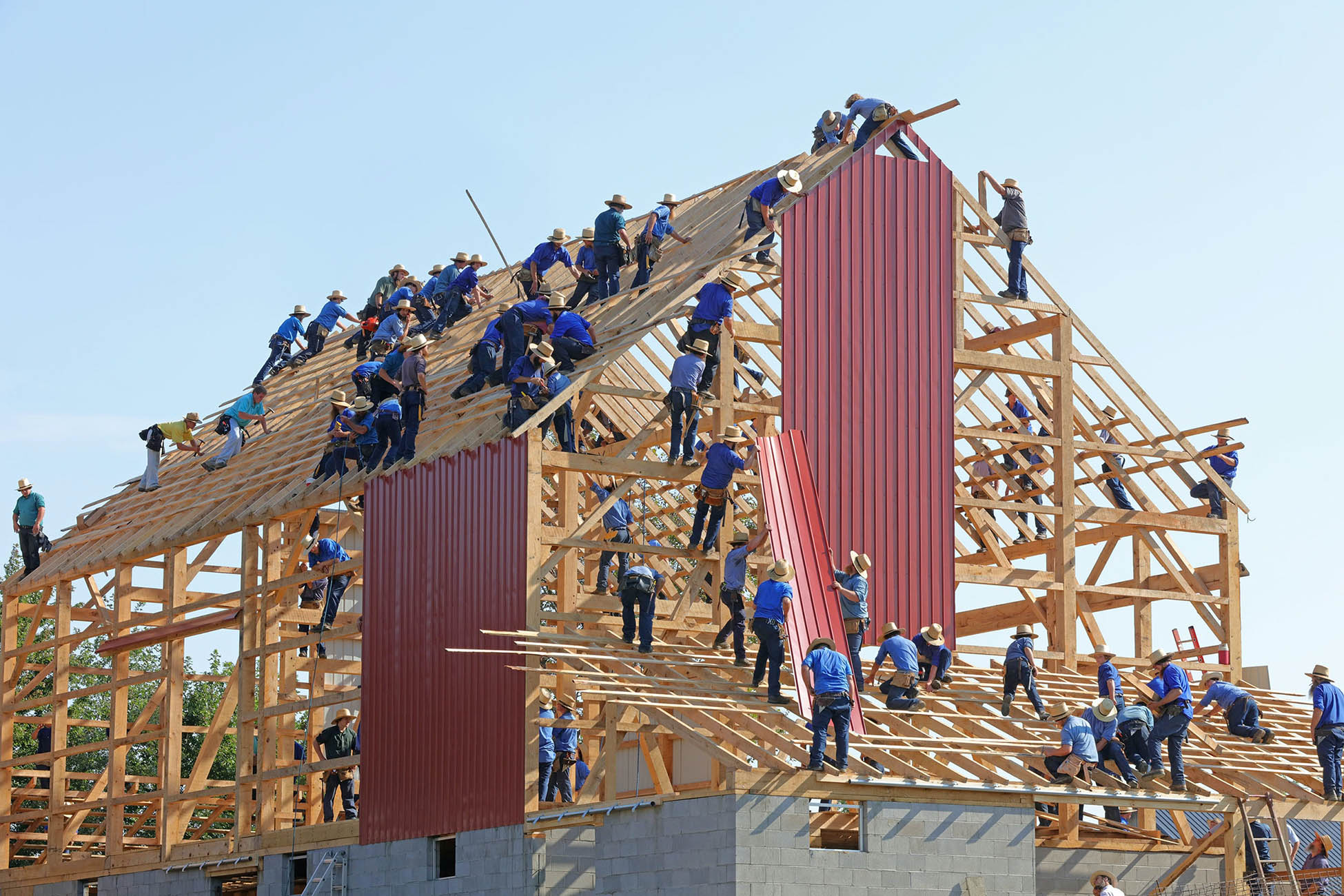Picture this: a house built from your wildest dreams, a space that screams your individuality, where every brick and beam echoes your vibe. Now, imagine getting a loan for that dream home without having to sacrifice your avocado toast budget. This isn’t a fairy tale—it’s the real world of financing a house build! Welcome to our comprehensive guide on how to get a loan to build a house, where we break down the nitty-gritty of construction loans, permanent mortgages, and every savvy financial decision you need to make, all served with a side of humor and practical advice for millennials and Gen Zers looking to win at adulting.
How to Get a Loan to Build a House Table of Contents
Understanding the Basics of House-Building Loans
Why Construction Loans Are Different (and Awesome)
The Different Types of Loans for Building Your House
Steps to Secure a Loan for Your House Build
Navigating the Financial Maze: Tips and Tricks for Success
Exploring Lender Options: Where to Find Your Financing Partner
Case Studies: From Dream to Reality—Real-Life Success Stories
The Role of Your Credit Score and Down Payment
Budgeting for Your Dream Build: More Than Just Loan Amounts
Managing Risks and Common Pitfalls
Resources and Community Support: Your Next Steps
Troubleshooting and Adjusting Your Plan on the Fly
Your Personalized Roadmap to Financing a Dream Build
Integrating Technology with Home-Build Financing
Embracing the Journey: More Than Just a Loan
FAQs: Your Top Questions Answered on Building a House Loan
Taking the Leap: What Your New Financial Journey Means for You
Understanding the Basics of House-Building Loans
Before we dive headfirst into the sea of paperwork and financial jargon, let’s chat about the basics. Getting a loan to build a house isn’t like snapping your fingers and having your dream home appear. It involves careful planning, a clear understanding of the different types of loans, and a willingness to navigate the maze of interest rates, down payments, and credit scores.
Essentially, when you’re asking, “How do I finance my home build?” you’re stepping into the world of construction financing. Unlike a standard home purchase loan, construction loans are designed to fund the building process itself. They come with unique features, such as disbursement schedules based on project milestones and potential conversion into permanent mortgages once construction is complete.
Whether you’re building a minimalist eco-home or a statement mansion that doubles as a creative hub for your entrepreneurial dreams, understanding the ins and outs of these financing options is your first step toward building a house that’s as unique as you are.
Why Construction Loans Are Different (and Awesome)
If you’ve ever tried to piece together an Ikea bookshelf without the instructions, you’ll understand why construction loans can seem daunting at first. These loans differ from traditional home mortgages in several crucial ways:
- Disbursement Milestones: Unlike a regular mortgage that pays the seller in one go, construction loans are released in stages. Think of it as a “financial progress bar” that unlocks funds as your house inches closer to reality.
- Short-term Nature: Construction loans are typically short-term solutions (usually 6 to 18 months), designed to cover the building phase before transitioning into a long-term mortgage or being paid off.
- Variable Interest Rates: Because construction projects involve a higher level of risk and uncertainty, interest rates can be adjustable during the construction phase. This means keeping a keen eye on market trends and being ready to pivot your financial strategy.
- Complex Approval Process: Lenders want to know that you’re serious about your dream house. Expect a thorough review of your credit history, financial stability, experience with construction (if any), and detailed project plans.
On the flip side, these features can actually work in your favor if you plan well. They allow you to manage cash flow effectively, mitigate risks by drawing funds as needed, and ultimately create a financial pathway that reflects the milestones of your build.
The Different Types of Loans for Building Your House
Not all loans for building a home are created equal. The financial market offers a buffet of options, each with its own flavors and benefits. Here’s a rundown of the main types you’re likely to encounter:
Construction Loans
These are the go-to loans when you’re physically putting up walls and roof beams. As mentioned, construction loans are short-term and structured to cover the building phase. They are typically interest-only during construction and may convert to permanent mortgages after the build concludes.
Construction-to-Permanent Loans
If you hate the idea of juggling multiple loans (and who doesn’t?), a construction-to-permanent loan might be your best friend. With this option, you apply once and get a construction loan that automatically converts into a permanent mortgage once your house is finished. It’s like a two-for-one deal that saves you both time and the hassle of requalifying.
Permanent Mortgages
Once your house is built, you might need a permanent mortgage to settle into a traditional long-term loan arrangement. Permanent mortgages come with fixed or adjustable rates and are what most people think of when they talk about “home loans.”
Bridge Loans
Sometimes, life throws you curveballs. A bridge loan can help you temporarily cover the gap between finishing your construction and securing a permanent mortgage, or even between selling your current home and buying/buiding a new one. It’s like borrowing time (and money) until you can seal the deal.
Choosing the right type of loan depends on your financial situation, the complexity of your build, and your risk appetite. It’s essential to have a solid plan in place and consult with financial advisors who understand the construction loan landscape.
Steps to Secure a Loan for Your House Build
Now that you’re warmed up to the idea of securing a construction loan, let’s break down the process into manageable, step-by-step directions. Think of it as your ultimate DIY guide to navigating the loan labyrinth:
Step 1: Evaluate Your Financial Health
First things first—take a long, hard look at your finances. This means checking your credit score (hello, credit report apps!), income, debt-to-income ratio, and available cash reserves. Lenders are like personal trainers—they’re tough critics who want to see that you’re in shape financially before they commit to you.
Brush up on your financial profile: paying off small debts, ensuring timely bill payments, and gathering documentation like tax returns, pay stubs, and bank statements will set the stage for a successful application.
Step 2: Develop a Detailed Construction Plan
Your lender isn’t just giving you money for a vague “project”—they’re investing in your house build. Prepare a comprehensive construction plan that includes:
- A detailed project timeline with milestones
- Itemized construction budgets
- Architectural and engineering plans
- Permits and local government approvals
The clearer your plan, the more comfortable lenders feel about your ability to complete the project on time and within budget.
Step 3: Shop Around for the Best Lender
Time to channel your inner detective and hunt down lenders with the best construction loan offers. Compare interest rates, fees, repayment terms, and overall customer service reviews. Don’t be shy—get quotes from multiple banks, credit unions, and specialized construction lenders. A little competitive shopping can save you precious dollars and headaches down the line.
Step 4: Get Pre-Approved
Pre-approval is like the golden ticket to the house-building factory. It shows that you’re a serious buyer and puts you one step ahead in the construction process. Pre-approval gives you a clear picture of your budget limits and demonstrates to builders and contractors that you’re ready to roll.
Step 5: Submit Your Loan Application
With your financials in check, your construction plan polished, and a lender or two on speed dial, it’s time to submit that loan application. Be prepared to provide all necessary documentation and answer questions about your project’s feasibility. This is your moment to shine by presenting a compelling case for your dream home.
Step 6: Manage Disbursement and Construction Phases
Once your loan is approved, the construction phase begins, and funds are disbursed in increments based on achieved milestones. Keep close tabs on the progress of construction, maintain regular communication with your contractor and lender, and be meticulous with paperwork to ensure each phase meets lender requirements.
Remember, the key to a smooth disbursement process is organization and transparency. Keep backup records, photos of project progress, and detailed invoices handy to avoid any hiccups along the way.
Navigating the Financial Maze: Tips and Tricks for Success
Even the savviest among us can feel overwhelmed by the twists and turns of construction financing. But fear not—here are some fun tips and down-to-earth tricks to keep you on track:
- Build Up Your Savings: A hefty savings account isn’t just impressive to your friends at dinner parties—it shows lenders you’re ready to handle unexpected expenses. Don’t forget to budget for contingencies!
- Mind Your Credit: Keep your credit score sparkling by paying off debts, correcting any errors on your report, and avoiding major financial moves before applying.
- Use Financial Tools: Apps and online calculators can help you track your spending, plan your budget, and calculate potential mortgage costs. Think of them as your financial sidekicks in this journey.
- Connect with a Loan Specialist: Sometimes, professional insight is key. A seasoned construction loan officer or mortgage broker can provide guidance, clarify confusing jargon, and help you tailor the best solution for your needs.
- Keep a Project Journal: Document every step of your building process. Not only will this help you stay organized, but it’s also a great way to reflect on your progress and celebrate each milestone.
When you mix disciplined planning with a touch of creativity and humor, navigating the financial maze can transform from a daunting obstacle into an exciting challenge—and you might even enjoy the ride.
Exploring Lender Options: Where to Find Your Financing Partner
The modern financial landscape is crowded with options, so picking the right lender is as essential as picking the right foundation for your house. Let’s break down the main players you should consider:
Traditional Banks
Big banks offer construction and mortgage loans with well-known brand reliability, a robust online presence, and an extensive branch network. While you might encounter more red tape here, the stability and reputation of traditional banks can be beneficial, especially for first-time builders.
Credit Unions
Often more community-oriented and flexible than large banks, credit unions can offer competitive rates and personalized service. If you’re eligible for membership, they can be a great alternative, providing local insights and often streamlined approval processes.
Specialized Lenders
There are lenders who specialize in construction loans and creative financing solutions. These institutions understand the unique challenges and opportunities of building a house and may offer tailored products, like construction-to-permanent loans.
Online Lenders
In today’s digital age, many borrowers opt for the convenience of online lenders. These platforms can offer quick pre-approvals, competitive rates, and an entirely digital application process, making them very appealing to tech-savvy millennials and Gen Zers.
When comparing lenders, pay close attention to:
- Interest rates and potential rate fluctuations
- Origination fees and closing costs
- Repayment terms and flexibility
- The lender’s reputation and customer service reviews
The right lender will not only fund your build but will also serve as a knowledgeable partner throughout the process.
Case Studies: From Dream to Reality—Real-Life Success Stories
Sometimes, real-life examples are the best way to see how it’s done. Here are a couple of success stories that demonstrate how a well-planned construction loan can transform your dream house into a tangible reality:
The Eco-Friendly Renovator
Meet Alex, a young professional with a passion for sustainable living. With a modest savings account and a brilliant vision for a zero-waste home, Alex decided to build a small eco-friendly house. Despite facing the typical hurdles of financing as a first-timer, Alex meticulously prepared a detailed construction plan emphasizing sustainable materials and energy-efficient technology. By leveraging a construction-to-permanent loan from a local credit union known for its community focus, Alex not only secured favorable interest rates but also found a supportive lender who understood the eco-friendly mission. Fast-forward a couple of years, and Alex’s home now stands as an inspiring beacon of environmental stewardship paired with financial savvy.
The Urban Innovator
Then there’s Jamie, a creative entrepreneur based in a bustling urban center, who dreamed of a custom-built studio apartment that served as both a living space and a creative hub. With a good credit score and solid professional track record, Jamie navigated through several lenders to eventually settle on a specialized online lender offering competitive terms for construction projects. With a well-documented renovation plan and a focus on maximizing every square foot in the city, Jamie’s construction loan was approved swiftly. The project was completed on time and within budget, transforming a once-nondescript lot into a vibrant space that fuels creative ideas every day.
These case studies highlight that no matter your budget or dream design, a smartly managed construction loan can be your ticket to turning dreams into concrete reality. And yes, sometimes a little faith, persistence, and a dash of financial wizardry can make all the difference.
The Role of Your Credit Score and Down Payment
When it comes to securing a loan to build your house, your credit score and down payment are like the dynamic duo of financing. Lenders scrutinize your credit history to determine how reliably you can manage debt, while your down payment demonstrates commitment and reduces the lender’s risk.
A robust credit score can open the door to lower interest rates and more favorable terms—think of it as your financial report card that shows you’re a responsible borrower. Likewise, a down payment (generally around 20-30% for construction loans) not only gives you an edge during negotiations but also helps keep your monthly payments more affordable.
If your credit score isn’t where you want it to be, consider taking a few months to improve it. Pay off outstanding debts, clear up any discrepancies on your report, and keep your credit utilization low. Every little step you take now can lead to major savings when it comes time to repay your loan.
Budgeting for Your Dream Build: More Than Just Loan Amounts
Securing a loan is only half the battle; managing your construction budget is where the real hustle begins. Beyond the loan amount, you’ll need to plan for:
- Construction Costs: Material, labor, permits, and unexpected overruns can add up quickly. Always plan for a 10-20% contingency fund.
- Design and Professional Fees: Architect, engineer, and designer expenses are crucial investments to ensure your house is both structurally sound and aesthetically pleasing.
- Land and Site Preparation: Don’t overlook the costs associated with purchasing land, clearing, grading, and installing essential utilities.
- Future Upgrades: Think ahead—maybe you want a smart home system, energy-efficient appliances, or custom landscaping. Include a rough estimate for these extras.
Creating a detailed budget not only helps you avoid unwelcome surprises but also builds confidence when negotiating with lenders. It’s like having a financial blueprint that mirrors your construction blueprint.
Managing Risks and Common Pitfalls
Let’s be real: building a house is a major financial adventure, and no great adventure comes without its risks. From fluctuating interest rates to unexpected construction delays, here are some common pitfalls—and how to dodge them:
Underestimating Costs
One of the most common mistakes is underestimating the total cost of your build. There’s a long list of “hidden” expenses that can materialize, so overestimate your budget and set aside extra funds.
Poor Project Management
Even if you secure the perfect loan, disorganized project management can derail your entire build. Regular site visits, constant communication with your contractor, and keeping detailed records are essential.
Market Volatility
Interest rates and material costs can fluctuate due to market conditions. Staying informed about market trends and having a flexible financing strategy can cushion you from sudden price surges.
While no one likes to think of obstacles, preparing for them in advance is the hallmark of a true financial ninja. Keep your eyes peeled, your documents in order, and your stress levels in check (yes, even when your Pinterest board is overflowing with design ideas).
Resources and Community Support: Your Next Steps
So, you’re ready to get started, but where do you turn for additional support and resources? The digital age offers a wealth of information and community-driven platforms that can help you stay on top of your financial game as you build your dream home.
Online Forums and Groups: Join Facebook groups, Reddit threads, or specialized forums like BiggerPockets, where fellow builders and homebuyers share their experiences, advice, and insider tips.
Financial Blogs and Podcasts: There’s a ton of content aimed at millennial and Gen Z audiences that breaks down complex financial topics in a fun, accessible way. Tune into podcasts or read blog posts that discuss real-world home-building strategies, money management, and current market trends.
Local Workshops and Seminars: Many communities offer free or low-cost workshops hosted by local banks or housing authorities. These sessions can provide insights into local building codes, available grants, and specialized financing options.
Consultation with Financial Advisors: If you feel overwhelmed, consider scheduling a meeting with a financial advisor who specializes in construction loans. Their expertise can help you tailor a strategy that fits your unique financial landscape.
Mobile Apps and Tools: Maximize your budgeting and planning with apps designed for construction projects. From expense tracking to project management, these digital tools can help keep your build organized and within budget.
By leveraging these resources and connecting with a community of like-minded individuals, you’ll not only brighten your financial outlook but also gain the confidence and support necessary to tackle any challenge on your path to home ownership.
Troubleshooting and Adjusting Your Plan on the Fly
Here’s a little secret: even the best-laid plans sometimes need a bit of tweaking. Building a house is a dynamic process, and occasionally, unexpected changes might prompt you to adapt your financing strategy.
If you hit a snag—like delays in construction, unexpected costs, or shifts in interest rates—remind yourself that flexibility is your superpower. Reach out to your lender to discuss options, adjust your budget, and, if needed, consult with your financial advisor to realign your objectives. Think of these adjustments as creative pivots that only make your journey more resilient and uniquely yours.
Every twist in the process is a chance to learn, improve your financial strategy, and emerge even more prepared for the future. So don’t sweat the small stuff—keep your cool, stay informed, and remember that each setback is simply setting the stage for a major comeback.
Your Personalized Roadmap to Financing a Dream Build
Crafting your own financing plan is an empowering process, one that involves self-assessment, diligent research, and a dash of creativity. Here’s a quick recap of the key steps to help you build your personalized roadmap:
- Assess Your Finances: Check your credit score, income, and savings. Improve your financial health before applying.
- Create a Detailed Construction Plan: Prepare architectural designs, cost estimates, and a timeline.
- Shop for Lenders: Compare traditional banks, credit unions, online lenders, and specialized construction loan providers.
- Get Pre-Approved: Secure a pre-approval to streamline your application process and build credibility.
- Submit Your Application: Provide all requested documentation and clearly articulate your build’s vision.
- Manage Disbursement: Stay on top of construction milestones and maintain meticulous records.
- Monitor and Adjust: Regularly review your progress, adapt as market conditions evolve, and consult with experts.
With this roadmap in hand, you’re well-equipped to navigate the ups and downs of the construction loan process, ultimately paving the way to a home that’s built on smart strategies and creative detours.
Integrating Technology with Home-Build Financing
In the era of smartphones and smart homes, technology plays a pivotal role in managing your construction loan. From budgeting apps to virtual consultations, tech tools can help simplify complex processes, making financial management more accessible than ever.
Online Calculators: Use mortgage and construction loan calculators to get quick estimates of your monthly payments, total interest, and various financing scenarios.
Project Management Tools: Platforms like Trello or Asana are not just for organizing work projects—they can be ideal for tracking your construction milestones, setting deadlines, and maintaining communication with contractors.
Digital Document Storage: Keep your documents safe and easily accessible using cloud storage solutions. This ensures that everything from permits to invoices is organized and always at your fingertips during the loan process.
Embracing technology not only streamlines the financial side of your build but also frees up time and energy for the creative aspects of home building. After all, who wouldn’t want more time to choose the perfect playlist for inspiring those design decisions?
Embracing the Journey: More Than Just a Loan
Securing a loan to build a house isn’t merely about paperwork and interest rates—it’s about embracing a journey that transforms your financial aspirations into a tangible, living space. Every step, from assessing your credit to watching your new home rise from the ground up, is a chapter in your unique story.
Approach each stage with an open mind and a willingness to learn. The process may be complex, but each challenge is a stepping stone towards greater financial literacy, personal growth, and ultimately, the home of your dreams.
With careful planning, a clear vision, and the right financial support, you’re not just building a house—you’re building a future that reflects who you truly are, all while maintaining a sense of humor and grace along the way.
FAQs: Your Top Questions Answered on Building a House Loan
We know there are a ton of questions swirling in your head about financing a construction project. Check out these frequently asked questions to get the clarity you need.
1. What is a construction loan, and how is it different from a standard mortgage?
A construction loan is a short-term, interest-only loan used to finance the building phase of your home. Unlike a traditional mortgage that pays for an already-built home, construction loans disburse funds gradually as milestones are met and typically convert to a permanent mortgage after the build is complete.
2. How do I know which type of loan is best for my building project?
It depends on your project scope, financial health, and long-term plans. A construction-to-permanent loan offers the advantage of a single application process, while separate construction and permanent loans might provide more flexibility in some cases. Consulting with a loan specialist can help determine what’s best for you.
3. What role does my credit score play in obtaining a construction loan?
Your credit score is crucial—it affects the loan amount you qualify for, your interest rate, and the overall approval process. A higher credit score generally means better loan terms, so it’s wise to maintain a strong credit history.
4. Can I still secure a construction loan if I have limited savings?
Yes, but lenders typically require a down payment (often around 20-30%) as well as a solid financial profile. If savings are limited, consider strategies to boost your credit score, reduce existing debts, or explore programs that may offer assistance.
5. What additional costs should I expect when building a house?
In addition to construction costs, you should budget for design fees, permits, land acquisition, contingency funds for unexpected overruns, and future upgrades like smart home systems.
6. How do I manage disbursements during the construction phase?
Funds are typically released in stages as construction milestones are met. It’s important to maintain good records, communicate closely with your lender, and schedule regular inspections to ensure smooth disbursement.
7. Are there any technological tools that can help with managing my construction loan?
Absolutely. Online calculators, project management apps, and digital document storage tools can significantly streamline your loan management and construction process.
8. What should I do if unexpected costs or delays occur?
Stay flexible and proactive. Revisit your budget, consult with your contractor and lender, and consider adjusting your plan as needed. A well-documented contingency fund can ease these moments.
Taking the Leap: What Your New Financial Journey Means for You
Financing the construction of your dream home is more than just a transaction—it’s an investment in your future, a chance to create a space that defines who you are. The process demands patience, persistence, and a willingness to ride out the ups and downs. But with this guide in your back pocket, a supportive community, and the right financial tools at hand, you’re fully prepared to take that leap.
Embrace the journey with enthusiasm, knowing that every form signed, every budget line checked, and every construction milestone reached is one step closer to living in a home built entirely by the vision of you. Here’s to making savvy decisions, learning on the fly, and, ultimately, enjoying a space that’s a true reflection of your personality and aspirations.
Now is the time to turn that dream into a blueprint and then into reality. Celebrate each small victory along the way, and remember, the challenges you overcome now will lay a strong foundation for both your house and your financial future.
Whether you’re an eco-warrior, an urban innovator, or someone pursuing a balanced lifestyle—you have the tools. Trust in your abilities, seek out advice when needed, and watch as your dream home, once just a sketch on a napkin, transforms into a stunning architectural reality.













